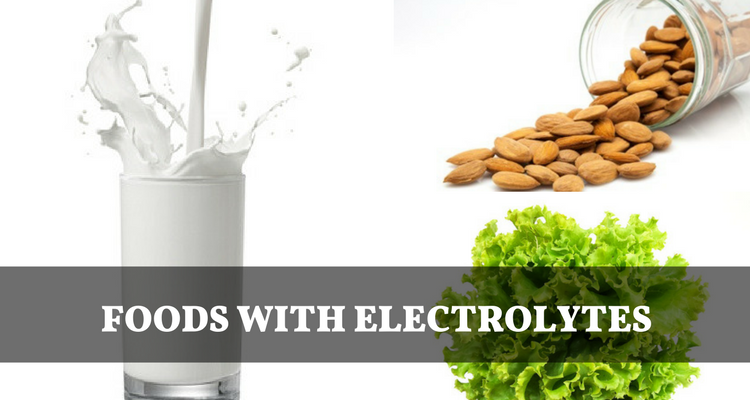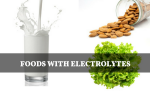
Electrolytes are essential minerals that are necessary for proper cellular function in the human body. We should include foods with electrolytes in our daily meals because they carry electrical charges across the body. These electrical charges stimulate the muscles and nerves throughout the body.
Electrolytes also maintain fluid balance in the body which affects cellular function, blood volume, and blood pressure. For muscles, bones, tissues, and nerves to remain healthy and perform functions efficiently, electrolytes are vital. Fruits and vegetables are wonderful sources of electrolytes.
Top 20 Foods with Electrolytes
Electrolytes are essential minerals. In other words, our body cannot produce them on its own, and thus, they must be supplied externally. The primary electrolytes required by the human body are sodium, potassium, calcium, magnesium, bicarbonate, and phosphate. In our daily life, we lose these electrolytes through sweat, urination, vomiting, and anything thrown out of the body in the form of fluids.
Since they are vital for good health and normal functioning, it is necessary to maintain their balance and replenish the body with these electrolytes, especially after exercise. Here are top 20 foods with electrolytes.
1. Yogurt
Prepared from milk, yogurt contains a good amount of calcium. It has 49% Daily Value (DV), which is crucial for bone health, and in hormone and enzyme secretion.
It is also a source of other electrolytes like potassium (17% DV), magnesium (12% DV), phosphorus (39% DV), and sodium (7% DV).
2. Bananas
Eat bananas to replenish the potassium content in the body, as they contain a high percentage potassium (23% DV).
Potassium regulates heart function and reduces the risk of stroke. Other minerals available in bananas are magnesium (15% DV), phosphorus (five percent DV), and calcium (one percent DV).
3. Watercress
This aquatic plant species has calcium (four percent DV) and potassium (three percent DV) in good amounts. Sodium (one percent DV), magnesium (two percent DV), and phosphorus (two percent DV) are also present in watercress.
4. Peanut butter or almond butter
Replace table salt with healthy snack foods like peanut butter or almond butter to increase sodium intake. Deficiency of sodium could lead to improper enzyme operation, muscle spasms, headaches, and fatigue.
Along with sodium, peanut butter or almond butter will also provide a good amount of protein and healthy fats. These foods with electrolytes may not be a good option to include in your daily diet, mainly because of their fat content.
5. Scallops
Seafood like bay and sea scallops are a good source of phosphorus (37% DV) and sodium (24% DV). Scallops also provide other minerals like potassium (eight percent DV), magnesium (eight percent DV), and calcium (one percent DV). Phosphorus works with sodium to improve and maintain bone and teeth health.
6. Coconut water
Infused with natural salts, especially potassium and magnesium, coconut water is an excellent way to load up on the electrolytes.
Coconut water works as a good hangover remedy as well. This is the best source of electrolytes for dehydration.
7. Spinach
Green leafy vegetables like spinach are rich sources of all the major electrolytes—magnesium (40% DV), calcium (25% DV), potassium (23% DV), phosphorus (11% of DV, and sodium (five percent of DV).
Magnesium is known to regulate blood sugar levels and blood pressure. It also plays a role in protein synthesis and energy metabolism.
8. Mushrooms
Cooked, white button mushrooms are healthy food items that will provide phosphorus (14% DV), sodium (16% DV), potassium (16% DV).
9. Swiss chard
Magnesium is found in considerable amounts (39% DV) in cooked Swiss chard. Other electrolytes include potassium (28% DV), sodium (12% DV), calcium (11% DV), and phosphorus (five percent DV).
10. Bok choy (Pak choi)
170 grams of this cooked Chinese cabbage variety contains potassium (19% DV), calcium (15% DV), magnesium (five percent DV), phosphorus (five percent DV), and sodium (two percent DV).
11. Dill pickles
A 135-gram serving of dill pickles has sodium (46% DV), calcium (eight percent DV), potassium (four percent DV), magnesium (three percent DV), and phosphorus (three percent DV).
12. Milk
One cup of wholesome milk contains calcium (29% DV), phosphorus (25% DV), potassium (10% DV), magnesium (seven percent DV), and sodium (five percent DV).
13. Soy milk
A good dairy substitute, one cup of unsweetened soy milk contains sodium (seven percent DV), potassium (seven percent DV), magnesium (seven percent DV), calcium (29% DV), and phosphorus (24% DV).
14. Beet greens
Another healthy green vegetable, beet greens contain sodium (14% DV), potassium (37% DV), magnesium (24% DV), calcium (16% DV), and phosphorus (6% DV) in a cooked 144-gram serving.
15. Swiss cheese
Dairy products are good sources of electrolytes. A 28-gram serving of Swiss cheese contains sodium (12% DV), potassium (one percent DV), magnesium (three percent DV), calcium (27% DV), and phosphorus (17% DV).
16. Butternut squash
Butter squash tastes similar to a pumpkin. A 205-gram serving contains sodium (21% DV), potassium (16% DV), magnesium (14% DV), calcium (eight percent DV), and phosphorus (six percent DV).
17. Yeast extract spread
A six-gram serving of Marmite yeast extract spread contains sodium (eight percent DV), potassium (four percent DV), magnesium (three percent DV), and phosphorus (one percent DV).
18. Butterhead lettuce
With an impressive water content, butterhead lettuce also has a good amount of electrolytes. It has potassium (four percent DV), magnesium (two percent DV), calcium (two percent DV), and phosphorus (two percent DV).
19. Raw celery
The benefits of celery come from its antioxidant properties and mineral content. A medium stalk (40 grams) of celery contains sodium (one percent DV), potassium (three percent DV), magnesium (one percent DV), calcium (two percent DV), and phosphorus (one percent DV).
20. Nuts
Nuts like almonds are great sources of magnesium. A cup of almonds contains magnesium (64% DV), calcium (25% DV), potassium (19% DV), and sodium (one percent DV). These foods with electrolytes have other nutritional benefits too. They are rich in folate and good fats.
Most of these foods with electrolytes can be made a part of your diet in some form or the other. In addition to their electrolytic content, they nourish your body in several ways.
The Benefits of Electrolytes
Electrolytes are chemical compounds that form ions in body fluids. They are important for maintaining a healthy balance in the muscle and nerve functions. To avoid muscle cramps and to keep the body well-hydrated, we should eat foods with ample amounts of electrolytes.
The main electrolytes (minerals) which are required by the human body are sodium, potassium, calcium, magnesium, and phosphorus. Here are some of the key benefits of electrolytes.
1. Sodium
It is found outside the cell body, in the plasma of the bloodstream. It plays a significant role in enzyme operation and muscle contraction. It also maintains fluid balance and regulates osmoregulation in the body. Sodium reduces the loss of water in urination.
2. Potassium
It is found inside the cell body. Potassium works with sodium to maintain normal blood pressure and provide relief from stroke and kidney disorders. It also enhances muscle strength.
3. Calcium
Calcium is essential to build and maintain good bone health. Calcium along with vitamin D helps keep the bones not only strong, but also may prevent blood pressure and diabetes.
4. Magnesium
This electrolyte acts as a co-factor in many enzyme activities of the body. Magnesium assists in different metabolic activities of the body, including smooth muscle relaxation around the bronchial tubes in the lungs, skeletal muscle contraction, and neuron activity in the brain.
5. Phosphorus
This electrolyte works in association with calcium to build and maintain strong bones and oral health. Phosphorus shields the bones, gums, and tooth enamel from the natural wear and tear of human life.
Whether we require foods with electrolytes for diarrhea or electrolytes for diabetics, it is essential to obtain a good balance of all these minerals. It is a good idea to consult a doctor to get the ideal composition based on your health condition, age, and level of physical activity.
Do Apples Have Electrolytes?
They don’t say an apple a day keeps the doctor away for no reason. Apples contain remarkable amounts of dietary fiber, antioxidants, phytochemicals, and other nutrients. Although they do not provide a high amount of electrolytes, collectively, they can contribute to your daily intake of other essential minerals. It is found that a cup of apple juice provides 250 milligrams of potassium, 20 milligrams of calcium, and 0.3 milligrams of iron.
The Journal of the American Medical Association published a study wherein the results showed that children suffering from a stomach bug recovered faster with apple juice as compared to an electrolyte-enhanced drink similar to Pedialyte. According to the researchers at the University of Calgary in Canada, apple juice is more effective in treating stomach flu with symptoms like diarrhea, vomiting, and mild dehydration than packaged electrolyte beverages.
In both the cases, apple juice provided relief in medical conditions that required electrolyte supplements. Therefore, we can say that apples have electrolytes and apple juice is one of the best sources of electrolyte drinks.
Easy Homemade Electrolyte Drink Recipe
Throughout the day, our body commonly discharges the electrolytes in form of sweat and urine. So, it is necessary to replenish these electrolytes or minerals from time to time. Along with eating foods with electrolytes, another easy way to restore electrolytes is by drinking electrolyte drinks. However, one should read the ingredient composition on the pack before consuming packaged electrolyte drinks.
Fresh and homemade electrolyte drinks are safer and healthier. Here’s an easy-to-make and delicious homemade electrolyte drink recipe for you to try.
Ingredients:
- ½ cup of fresh orange juice
- ¼ cup of fresh lemon juice
- 2 cups of plain or coconut water
- 2 tablespoons of organic honey or maple syrup
- ¹⁄8 teaspoon of Himalayan pink salt
Directions
Simply put all the ingredients in a blender, and blend them until a smooth liquid is obtained. Transfer the juice to a mason jar. Chill it for some time before consumption.
As we know, our body contains electrical charges. Therefore, electrolytes are as important as vitamins and proteins, because it is the electrolytes that can carry the electrical charge throughout the body. Either excess or insufficient amount of electrolytes can disturb the electrolyte balance in the body. An imbalance electrolyte levels can lead to muscle malfunctioning, twitching, weakness, and seizure in severe cases.
Electrolyte imbalance can also lead to conditions like hypercalcemia (excess calcium) that can cause kidney stones, or in worse cases, kidney failure. Severe hypercalcemia cases can also cause dementia, as the high calcium content can tamper with the functioning of the nervous system. Thus, it is very important to take foods with electrolytes in the appropriate amount for healthy physical and mental health.
Related:
Sources:
Nordqvist, C., “What Are Electrolytes? What Causes Electrolyte Imbalance?” Medical News Today, May 24, 2016; http://www.medicalnewstoday.com/articles/153188.php, last accessed March 9, 2017













